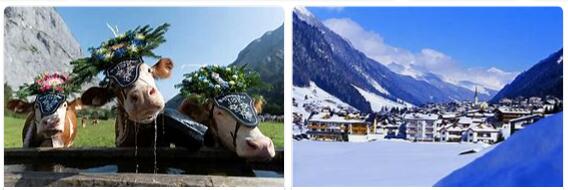Economy
With (2016) € 32,479 million, Tyrol contributes 9.2% to Austria’s gross domestic product (GDP). In a comparison of the federal states, it is in economic power with a GDP per resident of € 43,700 above the Austrian average of € 40,400 and takes fourth place in the comparison of the federal states. The service sector is comparatively strong, its share in gross value added (GVA; at manufacturer prices) is (2016) 71.1% (Austria: 71.0%), with tourism alone accounting for 13.9% (Austria: 5.0%). The manufacturing industry (including energy and water supply, construction) at 28.2% is just above the federal average (27.7%). The importance of agriculture and forestry is comparatively low (GVA share: 0.7%; Austria: 1.2%). The share of those employed in agriculture and forestry is 3.9% (2016) (Austria: 4.3%), in the secondary sector it is 26.1% (25.6%) and in the tertiary sector 69, 9% (70.1%). The unemployment rate was 6.4% (2016) (national average: 9.1%).
Agriculture: 9.1% of the area of Tyrol (excluding alpine pastures) is used for agriculture (including around 8 600 ha as arable land); alpine pastures have a share of around 15%; around 37% are forest. In the central Inn Valley there are mixed farms with a higher proportion of arable land (especially maize cultivation), otherwise grassland management predominates (in some cases with a high proportion of alpine pastures). Cattle breeding is geared towards both meat and dairy farming (especially cheese production); At around 83,200 (2016), the sheep population is the largest in Austria.
Natural resources: After the formerly important copper, silver, lead and zinc ore mining, mining is limited to the mining of magnesite in Hochfilzen near Fieberbrunn and the extraction of stones, earth and rock oil.
The energy industry is based on hydropower plants (several run-of-river power plants along the Inn and large storage power plants, including Sellrein-Silz, Kaunertal and Achensee). The shares of final energy consumption in 2015 according to energy carrier groups were: oil 43%, electrical energy 22%, renewable energies and waste 15%, gas 15%, district heating 4% and coal 1%.
Industry: Tyrol’s share of Austrian material goods production was 6.7% in 2016. The most important areas include machine and metal goods production, the vehicle industry, the chemical industry, wood processing, the production of food and beverages as well as the electrical and electronics industry. The main focus is on the companies in the Inn Valley and around Reutte (Lechtal).
Tourism: With around (2016) 47.6 million overnight stays (91.4% of which by foreigners), that is 33.6% of all overnight stays in Austria, tourism is an important economic factor. The main tourist attractions are the areas of Kitzbühel, Innsbruck, Seefeld, the Ziller, Stubai and Ötztal valleys, as well as the area around the Arlberg. The winter season accounts for more than half of the arrivals.
Transportation
A main transit connection between Italy and Germany runs through Tyrol: the Inntal and the Brenner autobahn (Kufstein – Innsbruck – Brenner). The enormous volume of traffic leads to a considerable burden on residents and the environment. Truck transit over the Brenner alone has more than doubled within 20 years: while around 852,000 trucks crossed the Brenner in 1990, the figure was 2.1 million in 2016.
The Brenner is the busiest Alpine transit route in Europe. A railway tunnel under the Brenner (Brenner Base Tunnel; BBT) is therefore intended to force the shift, especially of goods in transit, to rail; the main construction phase began in 2011 and completion is planned for 2025. The following are also important for through and long-distance traffic: the Arlberg motorway, especially as a connection to the Reschenpass, as well as the roads over the Fernpass, the Seefelder Sattel, the Achenpass, the Gerlospass and the Thurn Pass. The latter is in connection with the Felbertauernstraße (Felber Tauern) of decisive importance for East Tyrol. The most important routes for rail (freight) traffic are the Salzburg – Bregenz railway and, especially for international through traffic, the Kufstein – Innsbruck – Brenner route. Numerous cable cars and chair lifts were built for tourism. Innsbruck has an international airport.
Law
According to the Tyrolean provincial law of 1989 (changed several times), the state goals include the protection of the environment and the social market economy is fixed, the state legislation exercises a state parliament (36 members) that is elected for 5 years. The administration lies with the state government elected by the state parliament, which consists of the state governor as chairman, his two deputies and 5 state councilors.
Flag and coat of arms: The country’s flag is horizontally striped white over red and shows the country’s coat of arms in the middle. – The coat of arms of the federal state of Tyrol was first legally established in 1921 and described again during the constitutional reform in 1988: “The state coat of arms is the golden crowned and armored red eagle in the silver shield with golden wing clips with clover-leaf ends and a green wreath behind the head” (“Ehrenkranzl”; official component since 1918). The eagle had already been made the heraldic animal of the Counts of Tyrol before 1190. The oldest depiction is the one on the altar of the chapel of Tyrol Castle from 1370 (altar today in Innsbruck, Ferdinandeum).
